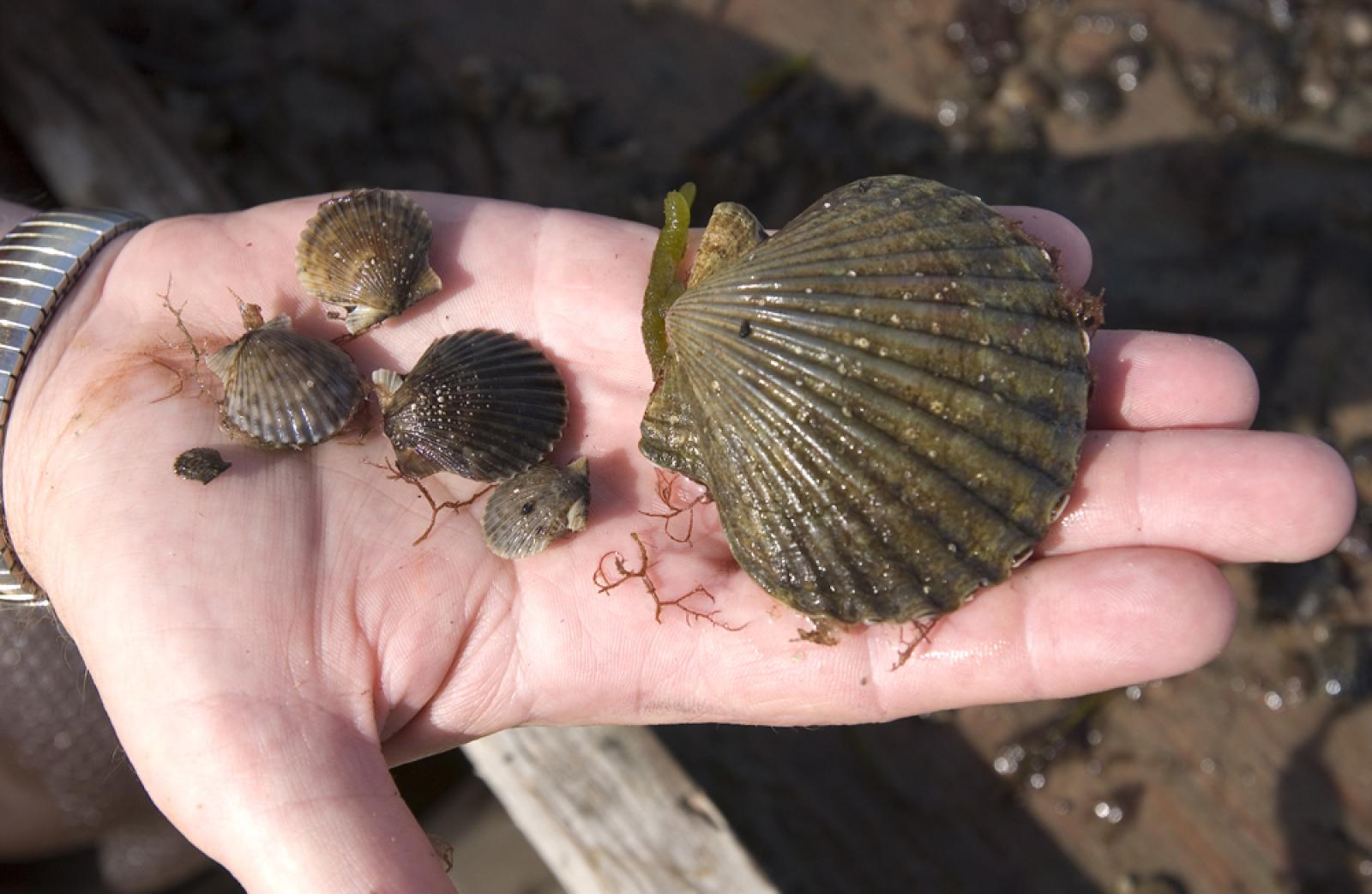Bay scallops have spawned with a vengeance this summer in Cape Pogue Pond. Once ranked among the most productive ponds for scallop landings in the state, Cape Pogue is teeming with juvenile bay scallops, many about the size of a dime.
It takes 18 months for a bay scallop to reach harvestable size, which means if these juvenile scallops survive the coming winter, predation and other environmental factors, the fall of 2011 will be a banner year for scalloping.
The news of a huge set of bay scallops follows the news earlier this summer of an enormous set of baby oysters in the Tisbury Great Pond.
“I think it is fantastic. We are tickled pink,” said Cooper A. Gilkes 3rd, chairman of the Edgartown shellfish committee, adding: “It means next year will be like Christmas.”
On Saturday, deputy shellfish constable Warren Gaines took the town power boat into Cape Pogue to have a close look at the scallop set. He dropped a scallop drag off Shear Pen pond, a secluded cove in the eastern end of the saltwater bay. After a 30-second tow, Mr. Gaines pulled the drag out of the water and dumped the contents onto a bare culling board. It was easy to see what shellfish department employees have been talking about for days: the drag was full of tiny bay scallops.
At 1,400 acres, Cape Pogue Pond is one of the largest of ponds on the Island, and Mr. Gaines believes the pond bottom is a blanket of seed. Wherever he drops a drag, he comes up with more of the same: over 100 bay scallops in each tow.
Mr. Gaines believes the spawning event probably happened over a period of days during the last two weeks of June and in early July. Scallops spawn when the water temperature warms; after that, wind and weather affect where the larvae settle.
But it is too early for big predictions; much can happen between now and the fall of 2011. Mr. Gaines said the shellfish department, with help from the shellfishermen, hopes to take steps to husband the young scallops and help their chances for survival. Already the northeast storm that lashed the Island yesterday created a hazard; wind-driven tides can throw the scallops onto the shore, fatally stranding them.
“It will be key for us to get those that are in shallow water, before they wash ashore,” Mr. Gaines said. The shellfish department plans to tow for the juvenile scallops and then take them out to deeper water. Some may be taken into Sengekontacket in an effort to boost the bay scallop population in that pond.
Clyde MacKenzie, a shellfish biologist with the National Marine Fisheries Service in New Jersey, has been making regular trips to Cape Pogue this summer. The 79-year-old Edgartown native has done considerable work and study over the years on bay scallops. Recalling when Cape Pogue was far more productive decades ago, he said: “It looks like it will be a spectacular season next year. I’ve never seen the seed so abundant.”
But Edgartown shellfish constable Paul Bagnall sounded a more conservative note. “Having the pond full of seed is step one. I don’t want to rain on anyone’s parade, but it is still early to tell what the fishing will be like next year,” Mr. Bagnall said.
He noted that Cape Pogue Pond had a productive season last winter because of a good set of seed two years ago. This past winter the season was extended for three weeks past the traditional March 31 closure.
Shellfish biologists are keeping a sharp eye on an algae bloom in the pond. On Saturday, several acres of the pond’s surface looked like rusty water. The algae is cochlodinium, a single cell dinoflagellate that small shellfish cannot digest. The algae is more common in southern waters, but Rick Karney, director of the Martha’s Vineyard Shellfish Group, said they were able to identify it last Friday.
“We’ve heard it is a problem, especially for oyster growers on Long Island. They did have an issue with it last year on Nantucket,” Mr. Karney said.
“We think we saw this last year in a Great Pond. But because the sample wasn’t preserved properly, we are not sure,” he added.
If the bloom stays in one area for too long, Mr. Bagnall said it can starve the shellfish.
“We hope that our winter weather will drive it back,” he said.
Meanwhile, there may be good scallop news in other Vineyard ponds this year; early reports indicate a good set in Menemsha Pond.
The Edgartown shellfish committee will hold a public hearing to discuss the upcoming scallop season on Sept. 21 in the town hall.







Comments
Comment policy »